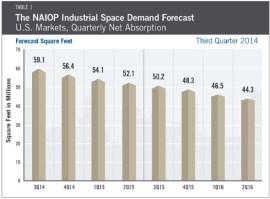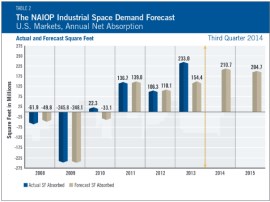by Brianna Crandall — September 15, 2014—A new report released by the NAIOP Research Foundation says that robust net absorption of industrial space is expected to continue throughout 2014 and 2015, registering 211 million and 205 million square feet respectively. These forecast net absorption figures are roughly 100 percent above those posted in 2011 and 2012 as the industrial market began its recovery.
Report highlights:
- The 2014 forecast of industrial space absorption is 211 million square feet
- Q3 and Q4 will average approximately 57.7 million square feet of net absorption — fairly robust and indicative of a healthy industrial space market.
- A slightly lowered rate of 205 million square feet of net absorption is forecast for 2015, further declining to approximately 174 million square feet in 2016.
“Industrial demand remains hot for all types of industrial space — fulfillment/distribution center, warehouse, manufacturing and flex,” said Thomas J. Bisacquino, president and CEO of NAIOP, the Commercial Real Estate Development Association. “A unique area of potential growth for industrial is in energy production and transport, as the nation has a renewed focus on domestic energy resources, and the possibility that the U.S. may begin exporting natural gas to Europe. These activities will likely generate increased industrial demand in port cities with high concentrations of energy production and supply chain activities.”
Study authors Dr. Hany Guirguis and Dr. Joshua Harris say that they year started with wildly variable economic activity, as the first quarter experienced a negative (-2.9 percent) annualized gross domestic product (GDP) growth rate, which was followed by a positive (four percent) preliminary reading in the second quarter.
Absorption of industrial space occurred at lower rates than expected in the first two quarters of 2014, due in part to the harshly cold winter that persisted into early spring. Robust hiring in recent months gives strong indications that the rest of 2014 will likely recover some of the lost activity and the economy will remand on a steady growth trend, concludes the report.
Looking ahead
The U.S. economy is expected to continue a slow to moderate growth trend in terms of GDP and employment growth. Accordingly, Harris and Guirguis forecast the same for industrial space demand. The predicted drop-off of activity beginning in late 2015 and continuing through all of 2016 is fueled in part by expectations of declines in labor force participation as more and more baby boomers enter retirement and thus generate less net demand for certain goods and services.
Further, sluggish growth in Europe and elsewhere in the world may temper some growth domestically. In summary, the forecast rate of net industrial space demand growth remains positive throughout 2016, but slightly tempered from prior forecasts due to changes in predictions of the underlying economic data.
“While we are encouraged by this positive growth in industrial, it is important to recognize that the same demand isn’t being experienced across the industry,” said Bisacquino. “The commercial real estate industry as a whole has yet to reach its full potential, due to uncertainties about fiscal policy and an unsteady economy.”
NAIOP, the Commercial Real Estate Development Association, is a leading organization for developers, owners and related professionals in office, industrial, retail and mixed-use real estate. NAIOP comprises 15,000 members in North America. NAIOP advances responsible commercial real estate development and advocates for effective public policy.







